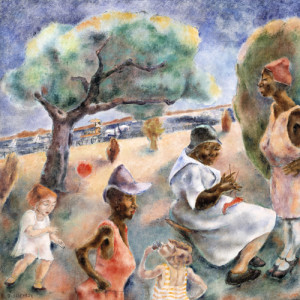The Battery, Evening, 1931
By George Biddle (American, 1885 – 1973)
Oil on canvas; 26 ½ 26 ½ inches
Gibbes Museum of Art (1999.002)
Enlarge
A native of Philadelphia, George Biddle graduated from Harvard Law School in 1911. He was admitted to the Pennsylvania Bar the same year, but instead he decided to pursue a career in art. From 1911 to 1916, Biddle studied in Europe and America at the Académie Julian in Paris and the Pennsylvania Academy of the Fine Arts. He learned printmaking in Munich and spent summers in Giverny with Frederick Frieseke. After serving in the army during World War I, Biddle traveled extensively visiting Tahiti, Mexico, and Paris.
In 1930, Biddle was commissioned by George and Ira Gershwin to illustrate the libretto for Porgy and Bess. He spent that spring in Charleston where he became friends with DuBose Heyward, author of the novel Porgy on which Gershwin’s opera was based. Charleston and its cultural reawakening inspired Biddle, and he created a number of paintings of life in the Lowcountry, including The Battery, Evening. This painting depicts nannies tending to children on the southern tip of the Charleston peninsula, an area known as The Battery.
< Back to Outside Perspectives: Visiting Artists in Charleston


